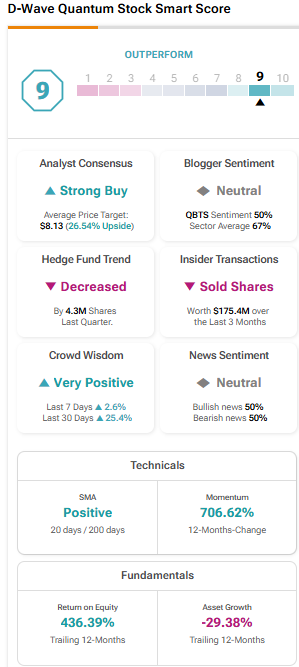D-Wave Quantum (QBTS): A Deep Dive Into Its Investment Potential In The Quantum Computing Sector

Table of Contents
Understanding D-Wave's Quantum Annealing Technology
D-Wave leverages quantum annealing, a unique approach to quantum computing. Unlike gate-based quantum computers which manipulate qubits to perform universal computations, quantum annealing focuses on solving specific optimization problems. It achieves this by finding the lowest energy state of a quantum system, representing the optimal solution.
D-Wave's advantage lies in its scalability; they've already built processors with thousands of qubits, significantly more than many gate-based competitors at this stage. This scalability translates to practical applications today, rather than just theoretical possibilities.
- Practical Applications: D-Wave's systems are currently being used in various fields, including materials science (discovering new materials with desired properties), logistics optimization (improving supply chain efficiency), and financial modeling (developing more sophisticated risk management strategies).
- Limitations: Quantum annealing is not a universal quantum computer. It excels at optimization problems but isn't as well-suited for other computational tasks that gate-based models can handle. Furthermore, the noise levels in current quantum annealing systems can impact the accuracy of solutions.
- Ongoing Research and Development: D-Wave continues to enhance its technology, focusing on improving qubit coherence times, reducing noise, and expanding connectivity between qubits. These ongoing advancements are critical for expanding the capabilities and applications of its quantum annealers.
D-Wave's Market Position and Competitive Landscape
D-Wave occupies a unique niche in the quantum computing market. While companies like IBM, Google, and Rigetti are primarily focused on gate-based quantum computing, D-Wave has carved a space for itself by focusing on practical applications of quantum annealing.
The quantum computing market is highly competitive, with significant investment from both private companies and governments worldwide. Key competitors include those mentioned above, as well as IonQ and others developing various quantum computing technologies. The competitive landscape is dynamic, with continuous advancements impacting market share.
- Partnerships and Collaborations: D-Wave has forged strategic partnerships with major corporations like Volkswagen, Lockheed Martin, and DENSO, leveraging its technology for real-world problem-solving. These collaborations demonstrate the value and applicability of D-Wave's quantum annealing approach.
- Market Size and Growth: The global quantum computing market is projected to experience exponential growth in the coming years. Factors like increasing government funding, private sector investment, and technological breakthroughs will fuel this expansion.
- Influencing Factors: Market share will be influenced by technological advancements (improving qubit quality, reducing error rates), government policies supporting quantum research, and the pace of adoption across various industries.
Analyzing the Investment Risks and Rewards of QBTS
Investing in QBTS, like any investment in a high-growth, early-stage technology company, carries inherent risks. The quantum computing sector is volatile, and D-Wave’s financial performance could fluctuate significantly. The company is still operating at a loss, and profitability is not guaranteed.
However, the potential rewards are substantial. If D-Wave succeeds in further developing and commercializing its technology, the returns on investment could be considerable. The company's current valuation reflects the potential of its technology and market position.
- Financial Performance and Projections: Investors should carefully review D-Wave’s financial statements, including revenue, expenses, and projections. These figures will provide a clearer picture of the company's financial health and future prospects.
- Valuation and Growth Potential: D-Wave's valuation reflects market expectations for future growth. Investors need to consider whether this valuation is justified given the company's current stage of development and market position.
- Risks of Investing in Quantum Computing: The quantum computing sector is still nascent and highly speculative. There’s a risk that the technology may not develop as quickly as expected, or that other technologies may emerge as more commercially viable alternatives.
Future Outlook and Potential for D-Wave Quantum
D-Wave's future hinges on several factors: continued technological advancements in quantum annealing, expansion into new market segments, and successful partnerships with industry leaders. The potential for breakthroughs in qubit coherence, reduced noise, and improved connectivity remains high.
Future applications of D-Wave's technology are extensive. Beyond current applications, we could see widespread adoption in drug discovery (accelerating the identification of new drug candidates), materials science (designing advanced materials with improved properties), and financial modeling (developing more accurate and efficient risk assessment tools).
- Potential for Significant Breakthroughs: Further advancements in qubit technology and algorithmic development could significantly expand the capabilities of D-Wave's systems, opening up new applications and markets.
- Impact of Government Regulations and Funding: Government funding and policies play a significant role in shaping the quantum computing landscape. Favorable regulatory environments and increased funding can accelerate D-Wave's growth.
- Long-Term Investment Potential: The long-term investment potential of QBTS is directly linked to D-Wave's ability to maintain its technological leadership, secure new partnerships, and expand its customer base. The growth of the overall quantum computing market will also significantly impact QBTS's long-term success.
Conclusion
This deep dive into D-Wave Quantum (QBTS) reveals significant potential in the burgeoning quantum computing sector. While inherent risks exist, D-Wave's established position, unique technology, and promising applications offer compelling reasons for investors to consider its stock. The future of quantum computing is bright, and D-Wave is well-positioned to play a significant role.
Call to Action: Consider adding D-Wave Quantum (QBTS) to your investment portfolio. Conduct thorough due diligence and consult with a financial advisor before making any investment decisions in the dynamic world of quantum computing and QBTS stock. Remember to stay updated on D-Wave Quantum's advancements and the wider quantum computing landscape to make informed investment choices. Research QBTS thoroughly before investing, understanding both the exciting possibilities and the inherent risks associated with this cutting-edge technology.

Featured Posts
-
 Dusan Tadic Fenerbahce Tarihine Gecti
May 20, 2025
Dusan Tadic Fenerbahce Tarihine Gecti
May 20, 2025 -
 Dzhennifer Lourens Vdruge Stala Mamoyu Pidtverdzhennya Ta Podrobitsi
May 20, 2025
Dzhennifer Lourens Vdruge Stala Mamoyu Pidtverdzhennya Ta Podrobitsi
May 20, 2025 -
 Germany Italy Quarterfinal Match A Preview And Prediction
May 20, 2025
Germany Italy Quarterfinal Match A Preview And Prediction
May 20, 2025 -
 Robert Pattinson And Suki Waterhouse Script Reading Session
May 20, 2025
Robert Pattinson And Suki Waterhouse Script Reading Session
May 20, 2025 -
 Odigos Efimerion Iatron Patras Savvatokyriako And Argies
May 20, 2025
Odigos Efimerion Iatron Patras Savvatokyriako And Argies
May 20, 2025
